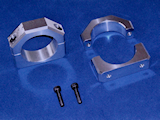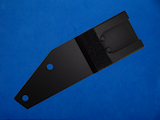Please Note:
This fork clamp collar and bracket is designed to fit a Kawasaki 650 Versys not the Yamaha FZ6 Fazer! However it is still a "homemade" item and I see no reason why a similar design with adjusted sizes could not be used on the Yamaha FZ6 Fazer if so desired.
The Idea:
There is a nice 52mm diameter machined section on the forks just below the bottom steering yoke that might make a suitable place for mounting the Drift X170 Action Camera. About 22mm in length it means the bracket or collar would not be to big and heavy and on initial inspection it will not interfere with the travel of the fork suspension movement. The plan is to construct a collar and arm to clamp to this machined area and project the Drift X170 Action Camera just below the headlight either on the right hand side or left hand side fork to give an alternative perspective when filming. The collar and arm is to be manufactured in such a way that there is some adjustment to the camera for fine tweaking of film angle.
The Fork Clamp Collar:
As there is 22mm of machined diameter spare on the bike forks it seems only logical to make the collar 22mm thick. The following is a rough guide to the manufacture of this fork clamp collar.
- Machine a piece of Aluminium or similar material to 76mm x 76mm x 22.2mm.
- Bore a hole diameter 51.5mm in the center of this block of Aluminium.
- Drill, counter bore and tap two holes suitable for M6 cap head bolts and machine block corners at 45 degrees on the top half only, (figure 2).
- Machine a 3mm by 45 degree chamfer around all edges, (figure 2).
- Scribe a two lines on the block, one on the center line, (38mm) and another 7mm lower. These will be the two halves finished sizes so split the block between these two lines, (Figure 3).
- Having split the block, machine the two halves to size, (38mm & 31mm). Bolt the two halves together and mark the mating edges to ensure a match after splitting, (figure 4). Re-bore the center hole to diameter 52mm.
- Machine 0.1mm off of each side face to ensure a nice blend occurs, (finish size 22mm).
- Re-split the two halves and machine 0.5mm off of the lower half of the mating face, this ensures a clamping force can be achieved around the fork.
- Machine two M6 tapped holes in the face of the collar lower half for housing the bracket arm, (figure 5 shows the split components and tapped holes).
The Bracket Arm:
As a rough estimate using a bit of trigonometry from some ruler measurements it was decided that the fork pitch angle was going to be around 24 degrees. Using this information a bracket arm was constructed to fit to the fork clamp collar. The following is a rough guide to manufacture of this bracket arm, (use the pictures opposite and the diagram below for reference).
- Machine a piece of Aluminium or similar material to 50mm x 167mm x 15mm.
- Machine 6mm deep step and 45 degree chamfer angle for approximately 100mm in length.
- Drill the two diameter 6.35mm holes through the plate, (M6 clearance holes).
- Turn the plate to a 24 degree angle and machine the slope angle to the holes)
- Use a 8mm thick diameter 20mm woodruff cutter to produce the slot for the supplied quick release mount plate, (shown in figures 9, 10 & 11).
- Using the supplied mount plate establish the position for the two pin stop holes.
- Drill and ream the two 6mm diameter pin stop holes, (shown in figure 7).
- Glue two diameter 6mm x 14mm long pins into the reamed holes, (shown in figure 9).
- Drill a diameter 5mm cross hole ready for producing the square retainer clip holes.
- Machine chamfers 2mm x 45 degree around profile for finish effect.
- Remove all sharp edges and burrs.
- Shot blast and paint bracket to desired colour, (take care not to get to much paint in the mount plate slot area as the paint thickness could affect the function of the slide fit and locking mechanism).
Fitting To The Bike:
All that remains now is to assemble the items and fit them to the bike. The camera alignment can be fine tuned by turning the collar on the fork leg so it is facing "true" forward or any desired angle. Other adjustments can be made to the Drift X170 Action Camera and mount as the lens is able to rotate and the supplied mount plate has notched grooves that allow incremental rotation and lock. Just for good measure a matching fork clamp collar was produced for the opposite fork so the bracket can be mounted to the left or to the right, the only difference being that the opposite fork has to have the camera mounted on the outside. |

Figure:1 Front view of the roughed out fork clamp collar before splitting and machining.
Fork Clamp Collar Front View.
Figure 1.
|

Figure 2: Top view of the roughed out fork clamp collar showing counter bored bolt holes, 45 degree block corners and 3mm by 45 degree edge chamfers.
Fork Clamp Collar Top View.
Figure 2.
|

Figure 3: Fork clamp collar showing scribed lines to mark finished machine size. Cut between these two lines when splitting.
Fork Clamp Collar Side View.
Figure 3.
|

Figure 4: Fork clamp collar side view showing identification marks for alignment after splitting and machining the 2 halves.
Fork Clamp Collar Side View.
Figure 4.
|

Figure 5: Showing the fork clamp collar components in their split and joined state.
Fork Clamp Collar Components.
Figure 5.
|

Figure 6: Showing the fork clamp collar in it's completed matt black spray painted finish.
Fork Clamp Collar Complete.
Figure 6.
|

Figure 7: Bracket arm showing side and face view profiles and chamfers.
Bracket Arm.
Figure 7.
|

Figure 8: Bracket arm isometric view showing profile, Drift X170 camera mount plate slot and square retainer clip holes.
Bracket Arm.
Figure 8.
|

Figure 9: End view showing the emulated slot and stop pins to house the Drift X170 camera mount plate, (shown in figure 11).
Emulated Mount Plate Slot.
Figure 9.
|

Figure 10: Isometric view of the bracket arm and fork clamp collar assembly showing stop pins.
Assembly.
Figure 10.
|

Figure 11: Drift X170 action camera supplied quick release mounting plate.
Supplied Mount Plate.
Figure 11.
|

Figure 12: Showing the completed bracket arm with it's matt black finish and soft anti-vibration pad to cushion the camera.
Bracket Arm Complete.
Figure 12.
|

Figure 13: Showing the completed bracket arm in an isometric view with it's matt black finish and anti-vibration soft pad.
Bracket Arm Complete.
Figure 13. |

Figure 14: This picture shows the bracket components and camera fitted to the bike in it's proposed position for video capture.
Fitted To The Bike.
Figure 14. |
![]()



![]()


